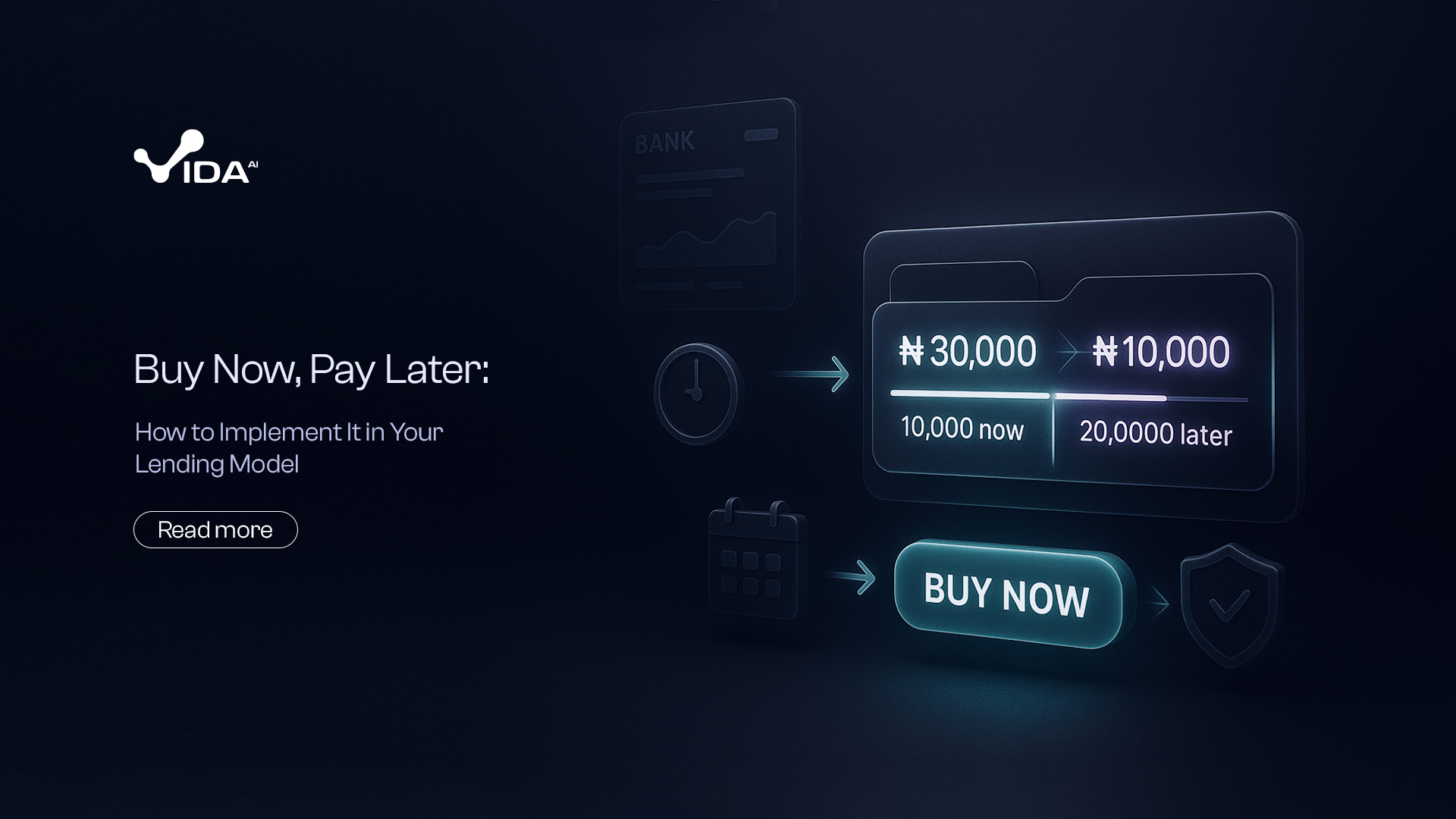back to Articles
Buy Now, Pay Later: How to Implement It in Your Lending Model

Eniayewu Josephine
Content Writer
Buy Now, Pay Later (BNPL) services have exploded from niche payment options to mainstream financial products, with transaction volumes exceeding $120 billion globally. This growth creates substantial opportunities for traditional lenders to capture market share through strategic BNPL implementation. Success requires understanding unique risk profiles, regulatory considerations, and integration strategies that differentiate BNPL from conventional lending products.
Understanding the BNPL Market Landscape
BNPL appeals to consumers across demographics, not just younger borrowers seeking credit access. Research reveals that 43% of BNPL users have established credit profiles and choose installment payments for budgeting convenience rather than credit necessity. This broad appeal creates opportunities for lenders to expand customer relationships beyond traditional loan products.
Transaction patterns show BNPL usage concentrated in retail categories including fashion, electronics, home goods, and travel. Average transaction values range from $50-$500, with repayment terms typically spanning 6-24 months. Understanding these patterns helps lenders target appropriate market segments and price products competitively.
Competitive dynamics favor lenders with existing customer relationships and sophisticated risk management capabilities. While fintech pioneers established the market, traditional financial institutions possess advantages in funding costs, regulatory compliance, and customer trust that enable sustainable competitive positioning.
Risk Assessment for BNPL Products
BNPL presents unique risk characteristics that require specialized assessment approaches. Unlike traditional loans evaluated primarily on repayment capacity, BNPL decisions must consider purchase behavior, merchant risk, and transaction context simultaneously.
Purchase timing and frequency patterns indicate responsible usage versus potential overextension. Borrowers making multiple BNPL commitments across different platforms may face repayment difficulties despite individual transaction affordability. Comprehensive risk models incorporate these behavioral indicators alongside traditional creditworthiness measures.
Merchant risk assessment becomes crucial since BNPL providers assume additional liability for disputed transactions and returns. Partner merchant selection and ongoing monitoring protect against elevated charge-back rates and customer service issues that impact portfolio performance.
Fraud risk differs significantly from traditional lending products. Identity theft, account takeover, and synthetic identity fraud require specialized detection systems that analyze device fingerprints, purchase patterns, and merchant interactions in real-time.
Technology Infrastructure Requirements
BNPL implementation demands robust technology infrastructure capable of handling high-volume, low-value transactions with minimal latency. Point-of-sale integration requires API connections with merchant systems, e-commerce platforms, and payment processors that enable seamless customer experiences.
Real-time decision engines must evaluate applications within seconds to avoid cart abandonment. Machine learning models processing alternative data sources, transaction history, and behavioral patterns provide accurate risk assessments without traditional underwriting delays.
Payment processing systems require automated installment scheduling, payment collection, and account management capabilities. Integration with existing loan management systems ensures consistent customer experience and operational efficiency across product lines.
Customer-facing applications need intuitive interfaces for account management, payment scheduling, and purchase tracking. Mobile optimization proves essential as BNPL usage skews heavily toward smartphone-based transactions.
Regulatory Compliance and Risk Management
BNPL regulation continues evolving as government agencies address consumer protection concerns. Truth in Lending Act (TILA) requirements may apply depending on product structure, requiring clear disclosure of payment terms and costs. Fair Credit Reporting Act (FCRA) compliance governs credit reporting practices for BNPL accounts.
State-level regulations vary significantly, with some jurisdictions treating BNPL as traditional lending while others create specific frameworks. Compliance programs must address multi-state operations and changing regulatory landscapes proactively.
Consumer protection measures include clear payment schedules, default remedies, and account management tools that prevent overextension. Responsible lending practices build customer trust while reducing regulatory scrutiny and reputational risks.
Data protection requirements intensify for BNPL products due to merchant data sharing and point-of-sale integration. Comprehensive privacy policies and security measures protect customer information while enabling necessary data flows for risk assessment and fraud prevention.
Integration Strategies for Existing Lenders
Traditional lenders possess significant advantages for BNPL implementation through existing customer relationships, established risk management systems, and regulatory compliance frameworks. Customer acquisition costs decrease substantially when offering BNPL to existing account holders who already trust the institution.
Cross-selling opportunities emerge when customers using BNPL services develop needs for traditional lending products like auto loans, mortgages, or personal loans. These relationships create lifetime value that justifies competitive BNPL pricing and service investments.
Brand recognition and consumer trust provide competitive advantages over fintech challengers. Established lenders can leverage reputation and customer confidence to capture market share from newer entrants lacking institutional credibility.
Funding cost advantages enable competitive pricing that fintech companies struggle to match. Access to low-cost deposits and established funding sources allows traditional lenders to offer attractive terms while maintaining profitable margins.
Revenue Optimization Models
BNPL revenue streams include merchant fees, late payment charges, and interchange income. Merchant fees typically range from 2-8% of transaction value, varying by industry, merchant size, and competitive positioning. Optimizing merchant partnerships through volume-based pricing and value-added services maximizes fee income.
Late payment fees require careful calibration to balance revenue generation with customer satisfaction and regulatory compliance. Excessive fees damage customer relationships and attract regulatory attention, while insufficient penalties fail to incentivize timely payments.
Premium service offerings create additional revenue opportunities through expedited funding, extended payment terms, and enhanced customer support. These value-added services appeal to merchants seeking competitive advantages and customers requiring specialized accommodation.
Cross-selling integration with existing products generates indirect revenue through expanded customer relationships. BNPL users who develop trust in the institution often pursue traditional lending products with higher profit margins and longer customer relationships.
Marketing and Customer Acquisition
BNPL marketing requires education about product benefits beyond simple payment deferral. Emphasize budgeting convenience, purchase flexibility, and transparent terms that differentiate quality offerings from predatory alternatives.
Partnership marketing with merchants creates customer acquisition opportunities at point-of-sale when purchase intent is highest. Co-marketing arrangements and merchant incentive programs drive adoption while strengthening business relationships.
Digital marketing strategies focus on retail and e-commerce channels where BNPL usage concentrates. Search engine optimization, social media advertising, and influencer partnerships reach target audiences effectively when timed with shopping behaviors.
Customer referral programs leverage satisfaction with BNPL experiences to drive organic growth. Referral incentives and social sharing features amplify positive experiences while building community around the brand.
Measuring Success and Optimization
Key performance indicators for BNPL programs include approval rates, merchant satisfaction, customer acquisition costs, and portfolio performance metrics. Balanced scorecards track financial performance alongside customer experience and operational efficiency measures.
Cohort analysis reveals customer behavior patterns, payment performance trends, and lifetime value progression. These insights inform product improvements, risk model refinements, and marketing strategy optimization.
Merchant feedback provides valuable insights into competitive positioning, service quality, and market opportunities. Regular merchant surveys and relationship management identify improvement opportunities and expansion possibilities.
A/B testing of product features, pricing structures, and user interfaces optimizes customer conversion and satisfaction. Continuous improvement based on data-driven insights maintains competitive advantages in rapidly evolving markets.
BNPL implementation offers significant opportunities for lenders willing to invest in appropriate technology, risk management, and customer experience capabilities. Success requires understanding unique market dynamics while leveraging existing institutional advantages to create sustainable competitive positions.
Sign Up Now to launch BNPL the right way and Turn checkout into a competitive advantage.

